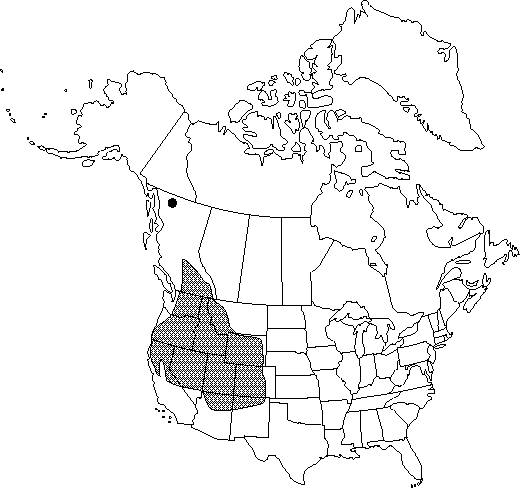Difference between revisions of "Delphinium nuttallianum"
in Walpers, Repert. Bot. Syst. 1: 744. 1842.
FNA>Volume Importer |
FNA>Volume Importer |
||
| Line 35: | Line 35: | ||
}}<!-- | }}<!-- | ||
| − | --><span class="statement" id="st- | + | --><span class="statement" id="st-undefined" data-properties=""><b>Stems </b>unbranched, 10-40(-70) cm; base reddish, pubescence variable. <b>Leaves</b> mostly on proximal 1/4 of stem; basal leaves 2-6 at anthesis; cauline leaves 2-10 at anthesis; petiole 0.4-12 cm. <b>Leaf</b> blade round, 1-6 × 2-12 cm, nearly glabrous; ultimate lobes 5-21, 5 or more extending more than 3/5 distance to petiole, width 1-7(-14) mm (basal), 0.5-6 mm (cauline), widest at middle or in proximal 1/2. <b>Inflorescences</b> 4-18(-48)-flowered, at least 2 times as long as wide; pedicel 0.8-6 cm, pubescence variable; bracteoles 3-8(-18) mm from flowers, green to blue, linear, 3-7 mm, pubescence variable. <b>Flowers</b>: sepals usually bluish purple, rarely white to pink, puberulent, lateral sepals reflexed or spreading, 8-21 × 3-10 mm, spurs decurved to straight, ascending 20-60° above horizontal, 8-23 mm; lower petal blades elevated, exposing stamens, blue to purple, except sometimes in white-flowered plants, 4-11 mm, clefts 2-5 mm; hairs mostly on inner lobes below junction of blade and claw, white, rarely yellow. <b>Fruits</b> 7-22 mm, 3.5-5 times longer than wide, glabrous to puberulent. <b>Seeds</b> winged or not; seed coat cell surfaces smooth or roughened, blunt hairs absent. <b>2n</b> = 16.</span><!-- |
-->{{Treatment/Body | -->{{Treatment/Body | ||
| Line 67: | Line 67: | ||
|publication year=1842 | |publication year=1842 | ||
|special status=Endemic;Weedy | |special status=Endemic;Weedy | ||
| − | |source xml=https://jpend@bitbucket.org/aafc-mbb/fna- | + | |source xml=https://jpend@bitbucket.org/aafc-mbb/fna-data-curation.git/src/9216fc802291cd3df363fd52122300479582ede7/coarse_grained_fna_xml/V3/V3_667.xml |
|genus=Delphinium | |genus=Delphinium | ||
|section=Delphinium sect. Diedropetala | |section=Delphinium sect. Diedropetala | ||
|subsection=Delphinium subsect. Grumosa | |subsection=Delphinium subsect. Grumosa | ||
|species=Delphinium nuttallianum | |species=Delphinium nuttallianum | ||
| − | |||
| − | |||
| − | |||
| − | |||
| − | |||
| − | |||
| − | |||
| − | |||
| − | |||
| − | |||
| − | |||
| − | |||
| − | |||
| − | |||
| − | |||
| − | |||
| − | |||
| − | |||
| − | |||
| − | |||
| − | |||
| − | |||
| − | |||
| − | |||
| − | |||
| − | |||
| − | |||
| − | |||
| − | |||
| − | |||
| − | |||
| − | |||
| − | |||
| − | |||
| − | |||
| − | |||
| − | |||
| − | |||
| − | |||
| − | |||
| − | |||
| − | |||
| − | |||
| − | |||
| − | |||
| − | |||
| − | |||
| − | |||
| − | |||
}}<!-- | }}<!-- | ||
-->[[Category:Treatment]][[Category:Delphinium subsect. Grumosa]] | -->[[Category:Treatment]][[Category:Delphinium subsect. Grumosa]] | ||
Revision as of 13:46, 27 July 2019
Stems unbranched, 10-40(-70) cm; base reddish, pubescence variable. Leaves mostly on proximal 1/4 of stem; basal leaves 2-6 at anthesis; cauline leaves 2-10 at anthesis; petiole 0.4-12 cm. Leaf blade round, 1-6 × 2-12 cm, nearly glabrous; ultimate lobes 5-21, 5 or more extending more than 3/5 distance to petiole, width 1-7(-14) mm (basal), 0.5-6 mm (cauline), widest at middle or in proximal 1/2. Inflorescences 4-18(-48)-flowered, at least 2 times as long as wide; pedicel 0.8-6 cm, pubescence variable; bracteoles 3-8(-18) mm from flowers, green to blue, linear, 3-7 mm, pubescence variable. Flowers: sepals usually bluish purple, rarely white to pink, puberulent, lateral sepals reflexed or spreading, 8-21 × 3-10 mm, spurs decurved to straight, ascending 20-60° above horizontal, 8-23 mm; lower petal blades elevated, exposing stamens, blue to purple, except sometimes in white-flowered plants, 4-11 mm, clefts 2-5 mm; hairs mostly on inner lobes below junction of blade and claw, white, rarely yellow. Fruits 7-22 mm, 3.5-5 times longer than wide, glabrous to puberulent. Seeds winged or not; seed coat cell surfaces smooth or roughened, blunt hairs absent. 2n = 16.
Phenology: Flowering spring (-early summer).
Habitat: Open coniferous woods, grassy sage scrub, meadow edges and well drained streamsides (generally not in very wet sites)
Elevation: 300-3500 m
Distribution

B.C., Ariz., Calif., Colo., Idaho, Mont., Nev., N.Mex., Oreg., Utah, Wash., Wyo.
Discussion
Delphinium nuttallianum represents an extremely difficult complex, with many variations in a number of morphologic traits. The complex has been and continues to be a major source of confusion for identification of Delphinium in North America. Type specimens of D. nuttallianum represent plants growing under dry conditions in open areas. These are typically found at 1200-2000 m in sage scrub or lower montane forest. Delphinium nuttallianum may be confused with D. andersonii, D. antoninum, D. depauperatum, D. gracilentum, and two subspecies of D. patens (subsp. patens and subsp. montanum). Features that may be used to separate D. nuttallianum from the first four, are enumerated under the respective species discussions. From D. patens subsp. patens, D. nuttallianum may be distinguished by its narrower leaf lobes, larger fruits, and more compact inflorescence. The frequent presence of glandular hairs in the inflorescence of D. patens subsp. montanum, contrasted with their absence in D. nuttallianum, will separate these taxa. Dwarfed plants of D. polycladon may be confused with D. nuttallianum. The latter, however may be distinguished by its ringed seeds, and it does not have prominent buds or sigmoid pedicel.
Hybrids have been seen between Delphinium nuttallianum and D. andersonii, D. depauperatum (D. ×burkei Greene), D. distichum (D. ×diversicolor Rydberg), D. nudicaule, and D. polycladon.
Selected References
None.